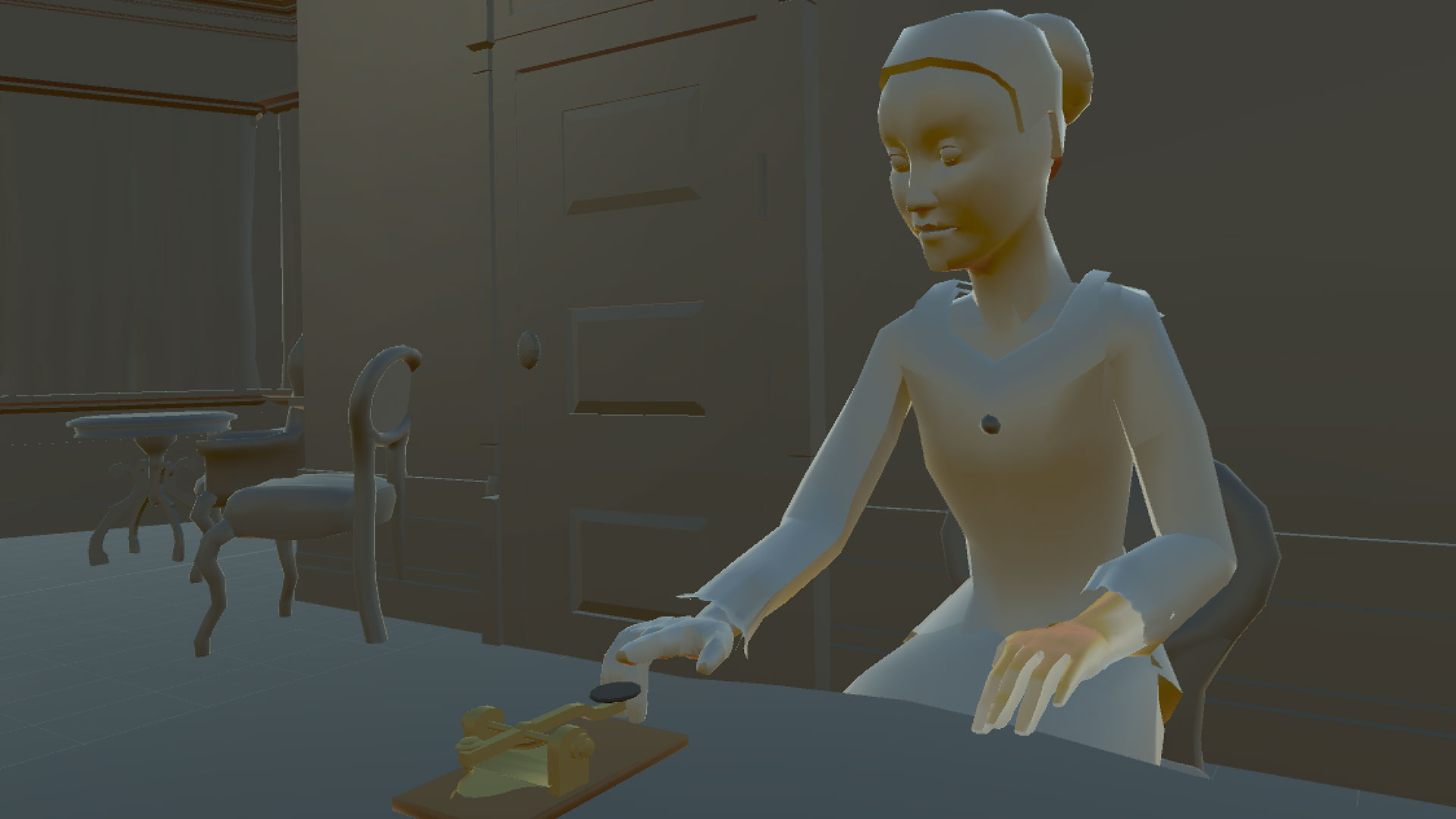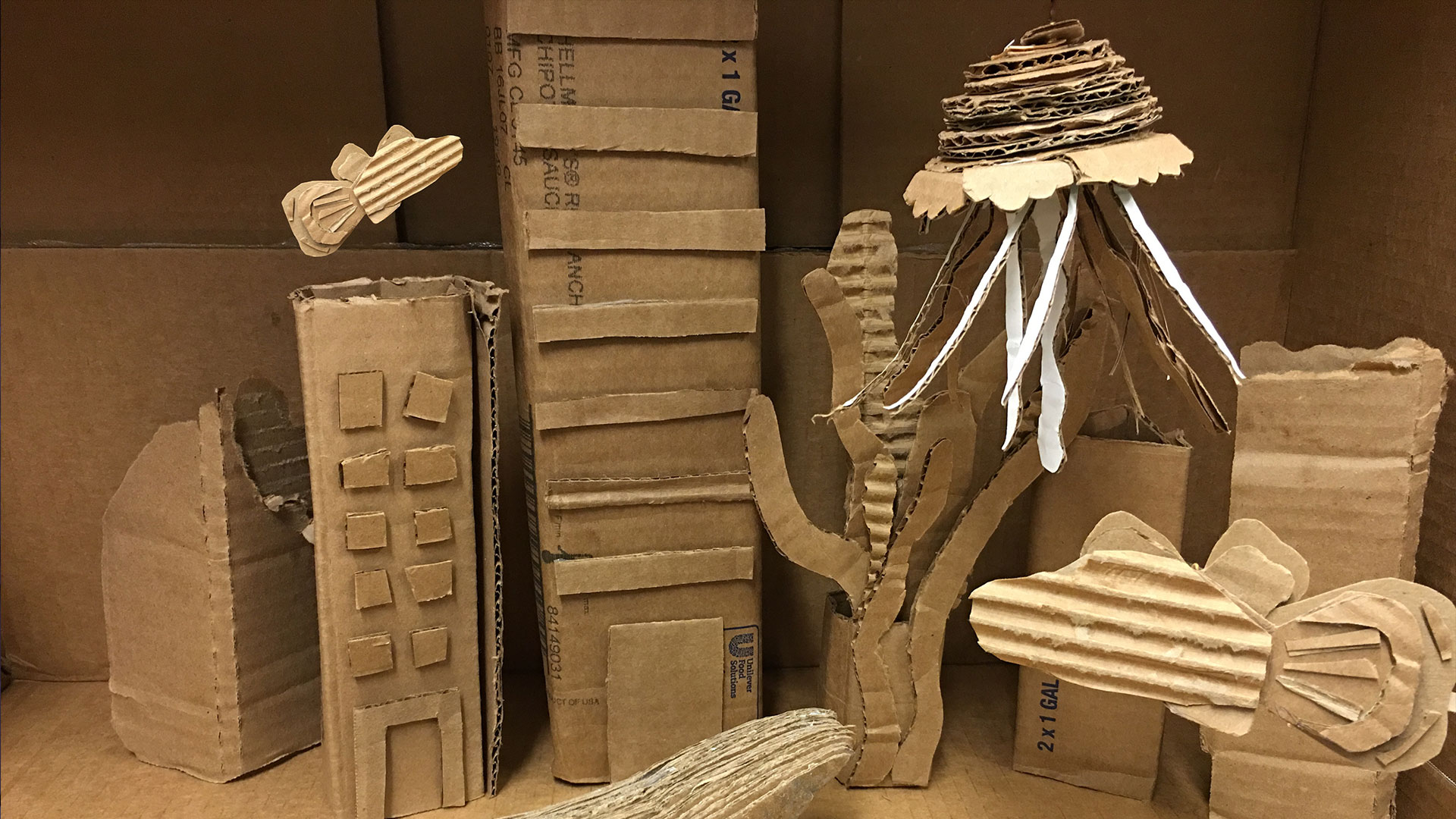Past Exhibition
Immersive Worlds Art Exhibition
April 7, 2016
Curatorial Statement
The Immersive Worlds Art Exhibition is a one-day event that layers augmented reality and virtual reality artworks to create a hybrid immersive environment. The exhibition is curated to highlight the interplay of viewers’ bodies as they actively engage with immersive technologies as physical objects, exposing the importance of materiality in virtual systems.
From headsets to handhelds, many contemporary technologies emphasize visual immersion. Optical experiences are given primacy whether the approach is augmented reality (AR), a technology for adding virtual computer-generated objects into the real world, or virtual reality (VR), a technology for replacing experiences of the real world with experiences of a computer-generated world. In contrast, this exhibition shows how we are already "immersed" in technology in a much more fundamental way. Communication technologies are all around us at all times, whether we "see" them as such or not. In the hands of artists, the optical capacity of immersive platforms can make visible certain aspects of these technologies that are usually hidden from our awareness. By overlapping multiple vectors of immersion—passing VR through AR, and vice versa—the exhibition draws attention to the technologies themselves. This engages not only our eyes, but our entire bodies, which share a world with technologies as material systems.
The artworks in this exhibition explore a diverse spectrum of technologies, both in form and content. Two VR projects by Ben Chang and Silvia Ruzanka are experienced on Oculus Rifts. A geo-tagged site-specific AR project by Will Pappenheimer is viewable on smartphones and tablets. A stereoscopy project using Google Cardboard is presented by team of Baruch New Media Arts students, Ivan Calderon, Alyssa D'Angelo, Mohamed Hassan, Iris Kim, Alexandra Perez, and Michelle Sheu.
Chang and Ruzanka's Spiritual Telegraph opens onto an early virtual world of telegraph networks. By today's standards the telegraph appears as a humble, low-bandwidth communications technology, but Chang and Ruzanka's work shows how even dots and dashes have the power to conjure rich narrative and emotional worlds. Ruzanka's Traversing the Sectors investigates a sonic and visual landscape of decaying hard drives, the ubiquitous workhorses that uphold all contemporary virtual systems. She shows how even when we are immersed in computer-generated worlds, our bodies continue to inhabit material spaces, in common with hardware, and subject to the vicissitudes of time. Pappenheimer's Transitional Spaces uses the smartphones and tablets we carry with us on our daily journeys as windows onto a world of forgotten files—3D portraits and objects which Pappenheimer discovered in the cloud, and which he visualizes floating throughout the college. His AR objects linger at the border between physicality and virtuality, much like the notion of “transitional objects” from developmental psychology. Cardboard Worlds, a collaborative project by Baruch’s New Media Artspace student docent team, uses a Google Cardboard viewer to survey a world constructed out of recycled cardboard. This project, in which recursion and immersion go hand in hand, is fashioned out of modest means to draw attention to the material language of new stereoscopy and DIY culture.
Spiritual Telegraph
Artists: Silvia Ruzanka and Ben Chang
Virtual reality and cyberspace have always contained a yearning to transcend the physical, whether overcoming distance through instantaneous communication or escaping the limits of the physical environment through sensory immersion. The telegraph, the first electronic communication network, prefigured many aspects of our contemporary cyberspaces. In our work with the telegraph we are also interested in the ways in which it was unique, representing not just a precursor but an alternate path for cyberspace and virtual reality.
The telegraph also figured prominently in the Spiritualist movement of the 19th century, a complex web of religious, mystical, philosophical, and political beliefs most well known for the idea that the spirits of the dead can communicate with the living. If the telegraph could be used to communicate across physical distances in this world, then why couldn’t the technology - or something like it - be used to communicate between worlds? This ’’celestial telegraph,’’ conveyed through the physical body of the Medium, was a way of transcending everyday physical reality and connecting with the Ether of Space beyond the atmosphere. In this piece, we explore this concept of the material and immaterial in connection to our contemporary ideas of the real and the virtual.
Transitional Spaces
Artist: Will Pappenheimer
Transitional Spaces is an augmented reality (AR) artwork installation which creates an immersive liminal space for emerging 3D virtual found objects and portraits from crowd sourced online model sites. The work is situated in the Baruch College Performing Arts Center in the three-story B2 Level Lobby and is visible throughout and around the building. Ephemeral everyday objects, figures and optical patterns cascade downwards through the cavernous lobby space viewed through the mobile AR app, Layar. The installation is inspired by the child developmental concept of a "transitional" or "comfort" object or space, which stands in for the intimate all-encompassing mother-child relationship. This psychoanalytic concept was first identified by DW Winnicott in the 1950s and 60s, and concerned the role of certain childhood objects as intermediaries between a sense of "me" and "not-me" and immersion or separation with respect to the mother. Here, the principal is extended to contemporary mixed reality objects and spaces composed in physical and virtual worlds. The work explores the implications of VR and AR as a negotiation of internal and external surround space. From this vantage point, the expansion of user generated shared sites for realistic 3-D and photogrammetric models suggests the need to transpose physicality into virtuality such that these elements might be seen as "transitional" to our accelerating movement towards cyberspace.
Traversing the Sectors
Artist: Silvia Ruzanka
In this age of the cloud and of big data, it's easy to think of digital data as purely intangible. However, data always exists within a physical device, whether that’s the hard drive, the computer memory, or the network switch. I'm interested in this materiality of data, and what happens when the underlying mechanism starts to fail and erode. When a hard drive starts to fail, invisibly, the first sign is often a change in the noises it makes; that change to the smooth sound of the motor at 5400 RPM, halting, spinning up, sputtering out; the so-called "click of death" as the arm snaps back and forth across the magnetic platters. Recording and amplifying these sounds with handmade contact microphones, I constructed an imagined soundscape of data in decay, and use this sound in turn to generate the visual landscape. In a sense this is a kind of data visualization, but the data itself is inaccessible.
Cardboard Worlds
Artists: Ivan Calderon, Alyssa D'Angelo, Mohamed Hassan, Iris Kim, Alexandra Perez, and Michelle Sheu (The New Media Artspace Docent Team)
Starting from an early age, artists remember themselves hiding in cardboard boxes and dreaming of their own worlds. Now as we are observing the convergence of virtual and real worlds and trying to foresee the future of technology, we are intrigued by the choice of material made by Google to produce an immersive experience. Google Cardboard is the medium in the New Media Artspace docents' message to push for a closer examination of what cardboard means to us, and what we can do with it looking forwards.
Google Cardboard is an affordable virtual reality viewer that enables its users to enter a multiplicity of worlds and sensations. It is highly accessible and simple to build, reworking the idea of cardboard into our thought frames of high technology and its emergent trends for innovation. Cardboard Worlds is a cut, fold, twist and rip remix of the cardboard material in its dual function of a viewer and of an environment that we invite you to step inside, explore, and #JoinTheFold.
In a dimensional, layered narrative of an underwater metropolis buoyant with sea creatures and reefs, we explore the intimate dimensionality of this dwelling. The underwater ecosystem props the city with representations of living, breathing inhabitants that reflect the organic material process of cardboard. Cardboard Worlds is a call to recognition and inspiration with the possibilities of material, immersive technologies.
Artists' Bios
Ben Chang
Ben Chang is an electronic artist and designer who creates virtual reality environments, interactive installations, and digital games. Combining a background in fine art and computer science, his work explores the chaotic, human qualities in technological systems. His work has been exhibited in numerous venues worldwide, including SIGGRAPH, FILE Sao Paulo, the Athens MediaTerra Festival, the Wired NextFest, and the Vancouver New Forms Festival, among others. He is an Associate Professor in the Department of the Arts, and Director of the Games and Simulation Arts and Sciences Program at Rensselaer Polytechnic Institute in Troy, New York.
Silvia Ruzanka
Silvia Ruzanka is a media artist whose projects include video, installation, performance, and virtual environments. Her work is concerned with the archaeology and memory of technology and media, and their intersections with everyday life. She has presented her artwork and research at numerous galleries, museums, and international festivals. Silvia holds an MFA in Art and Technology from the School of the Art Institute of Chicago. She currently lives and works near Albany, New York, and teaches digital art and animation at Rensselaer Polytechnic Institute.
Will Pappenheimer
Will Pappenheimer is a Brooklyn based artist and educator working in new media, performance and installation with an interest in institutional or spatial intervention and the altered meaning of things. His work often explores the confluence and tension of the virtual and physical worlds. For the past six years he has pioneered the use of mobile augmented reality as an artistic medium and is a founding member of the international Manifest.AR collective. His projects and performances have been shown at Whitney Museum of American Art, LACMA, Los Angeles; San Francisco MOMA; Stedelijk Museum in Amsterdam; FACT, Liverpool, UK; Contemporary Istanbul Art Fair, Istanbul; Kunstraum Walcheturm, Zurich; Fringe Exhibitions in Los Angeles; the ICA, Boston; the Museum of Fine Arts, Boston; Exit Art and the New Museum in New York; the Corcoran Gallery of Art in Washington; the Golden Thread Gallery, Belfast; FILE, Sao Paulo, BR; Turbulance.org; Xi’an Academy of Art Gallery in China. The artist’s works have been reviewed in Christiane Paulʼs recent historical edition of ’’Digital Art,’’ Art in America, New York Times, Hyperallergic.org, WIRED, Modern Painters, the Boston Globe, EL PAIS, Madrid, Liberation, Paris, and Art US. He teaches new and locative media at Pace University, New York.
The Immersive Worlds Art Exhibition is a collaboration between the New Media Artspace at Baruch College and the Immersive Worlds Conference convened by Baruch Performing Arts Center (BPAC) and the Weissman School of Arts and Sciences. The first New Media Artspace exhibition to be held “offsite” in BPAC, it has been generously supported by the Baruch College Maker Hub, the Lawrence N. Field Center for Entrepreneurship, the Newman Library, and Baruch Computing and Technology Center (BCTC).
Visit Us
Public Hours
The gallery is open to the public by appointment during regular library hours. Please contact newmediaartspace@gmail.com to arrange a visit.
Location
151 E. 25th StreetNew York, NY 10010
Located in the Newman Library
About Us
The New Media Artspace is a teaching exhibition space in the Department of Fine and Performing Arts at Baruch College, CUNY. Housed in the Newman Library, the New Media Artspace showcases curated experimental media and interdisciplinary artworks by international artists, students, alumni, and faculty.
Follow Us
Feedback
Have thoughts about our exhibitions? Leave a comment here!







